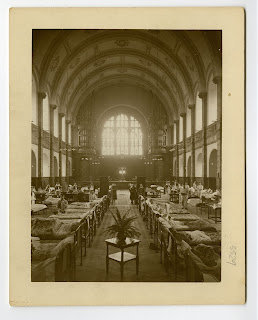 |
| Great Hall, University of Birmingham |
In late 1914 plans were made to establish auxiliary hospitals in large private houses across Birmingham, predominantly in the south of the city. While we found out a lot about some sites in the city that were used as hospitals during the First World War (i.e. the University of Birmingham, Highbury Hall in Moseley), others were initially more mysterious.
For example, in the Edgbaston and Harborne areas of the city we were aware that at least 5 buildings were donated for use as convalescent homes: Lordswood House on Lordswood Road; Stapylton House, St Peter’s Road; Mayfield, Harborne Road; Hillcrest, Richmond Hill Road; Harborne Hall, Old Church Road. We found out that Hillcrest had been established in November 1914 and was the first to be operated by the Voluntary Aid Detachment, staffed by a St John’s Ambulance unit. These voluntary units had been established in 1909 with the help of the Red Cross and the Order of St John. By the summer of 1914 there were over 2,500 VADs in Britain. In addition to British soldiers, many wounded Belgians were sent to Hillcrest in the autumn of 1914. Hillcrest had only 30 beds but soon moved to Harborne Hall on Old Church Road and expanded to 126 beds. It was funded by donations from employees of the Avery munitions works. During the Somme campaign of 1916 the nurses had to resort to putting mattresses on top of billiard tables in order to accommodate the extra wounded they received.
But what of the other three homes, Lordswood, Stapylton and Mayfield? The excellent website The Long, Long Trail [http://www.1914-1918.net/southerngen.htm] informed us that Lordswood had been established by the VAD in May 1915, with 30 beds that eventually expanded to 70. It treated 2,152 casualties in total. In Thekla Bowser’s book The Story of British VAD Work in the Great War, an invaluable resource for our project, she describes that many of the men resident at Lordswood worked in the kitchen garden as soon as they were able which not only had health benefits but also gave them an insight into outdoor working, a possible option for them after the war.
We have found less on Stapylton and Mayfield. Stapylton House opened as a 35-bed annexe to Harborne Hall in May 1917. Funds were provided by, among others, employees of W & T Avery, the weighscale manufacturers. Mayfield was established last, sometime in 1918, as an auxiliary hospital for officers.
Our Untold Stories learning resource will be publicly launched on 13 September 2016 at 6:30 to 8pm at Highbury Hall – join us to find out more.
Following the launch the learning resource will be available via this website.



I have a number of photos from a relative who nursed at Harwood VAD Hospital in Harborne if you’re interested.
Many thanks
Sally Warren
Sallywarrentr7@aol.com